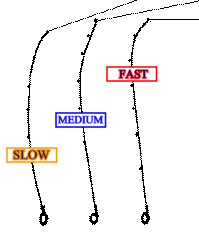Rod Action
|
Fly rods are made with a variety of flexing characteristics and capabilities referred to as "rod action." Actions are generally described as "Slow Action", "Medium Action", and "Fast Action". This flexing or bending is designed to meet a wide range of fly casting requirements demanded by different species of fish and fishing circumstances. These characteristics are meaningful because they relate directly to how a fly rod "loads". By "load" we mean the process of "cocking" the rod with the weight of the fly line by the action of the flycast. Depending on how aggressive the casting stroke is applied and the flexing characteristics of the rod, various degrees of "linespeed" are created. Linespeed
"Linespeed" in its simplest terms is how fast the fly line is traveling through the air as it is cast. A higher linespeed results in more velocity which creates more rod load, and hence more energy in the line which is better able to overcome air resistance and hence adds distance to the cast. Slower linespeed creates less velocity, less energy for rod load, and more wind resistance, and results in a shorter, "gentler" cast. |
